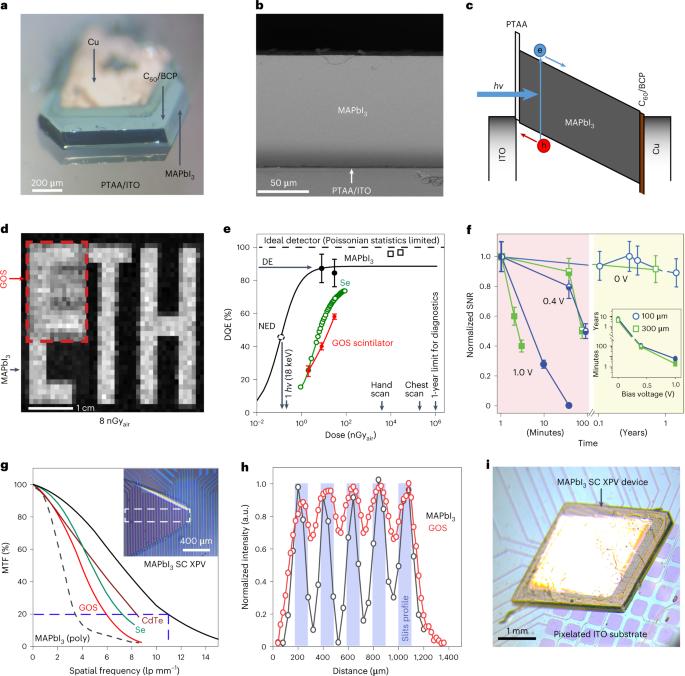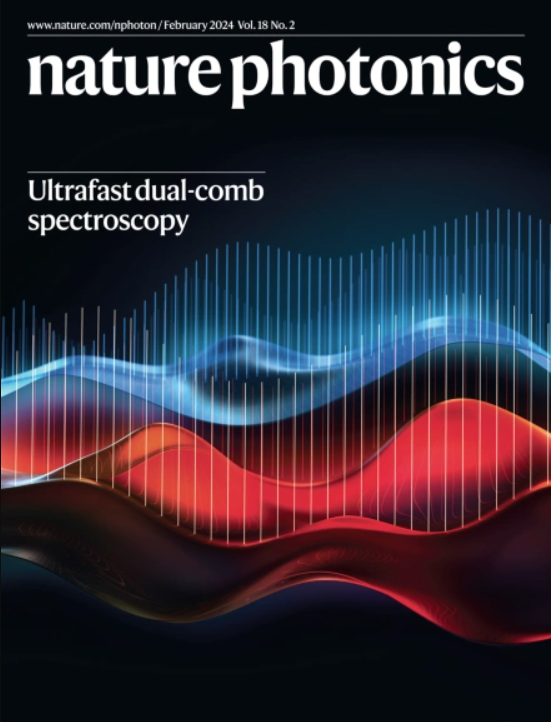Stable perovskite single-crystal X-ray imaging detectors with single-photon sensitivity
IF 32.3
1区 物理与天体物理
Q1 OPTICS
引用次数: 0
Abstract
A major thrust of medical X-ray imaging is to minimize the X-ray dose acquired by the patient, down to single-photon sensitivity. Such characteristics have been demonstrated with only a few direct-detection semiconductor materials such as CdTe and Si; nonetheless, their industrial deployment in medical diagnostics is still impeded by elaborate and costly fabrication processes. Hybrid lead halide perovskites can be a viable alternative owing to their facile solution growth. However, hybrid perovskites are unstable under high-field biasing in X-ray detectors, owing to structural lability and mixed electronic–ionic conductivity. Here we show that both single-photon-counting and long-term stable performance of perovskite X-ray detectors are attained in the photovoltaic mode of operation at zero-voltage bias, employing thick and uniform methylammonium lead iodide single-crystal films (up to 300 µm) and solution directly grown on hole-transporting electrodes. The operational device stability exceeded one year. Detection efficiency of 88% and noise-equivalent dose of 90 pGyair are obtained with 18 keV X-rays, allowing single-photon-sensitive, low-dose and energy-resolved X-ray imaging. Array detectors demonstrate high spatial resolution up to 11 lp mm−1. These findings pave the path for the implementation of hybrid perovskites in low-cost, low-dose commercial detector arrays for X-ray imaging. We show perovskite X-ray detection at zero-voltage bias with operational device stability exceeding one year. Detection efficiency of 88% and noise-equivalent dose of 90 pGyair are obtained with 18 keV X-rays, allowing single-photon-sensitive, low-dose and energy-resolved X-ray imaging.

具有单光子灵敏度的稳定钙钛矿单晶X射线成像探测器
医用 X 射线成像的一个主要目标是最大限度地降低患者所摄入的 X 射线剂量,达到单光子灵敏度。目前只有碲化镉和硅等少数几种直接探测半导体材料具有这种特性;然而,它们在医疗诊断领域的工业应用仍然受到复杂而昂贵的制造工艺的阻碍。混合卤化铅包晶石因其易于溶液生长而成为一种可行的替代材料。然而,由于结构的不稳定性和电子-离子混合导电性,混合过氧化物在 X 射线探测器的高场偏压下并不稳定。在这里,我们利用厚而均匀的甲基碘化铅单晶薄膜(长达 300 微米)和直接生长在空穴传输电极上的溶液,展示了在零电压偏置的光电工作模式下,包晶石 X 射线探测器既能进行单光子计数,又能实现长期稳定的性能。设备的运行稳定性超过一年。利用 18 keV X 射线可获得 88% 的探测效率和 90 pGyair 的噪声等效剂量,从而实现单光子敏感、低剂量和能量分辨 X 射线成像。阵列探测器的空间分辨率高达 11 lp mm-1。这些发现为在用于 X 射线成像的低成本、低剂量商用探测器阵列中使用混合包晶铺平了道路。我们展示了在零电压偏置下的包光体 X 射线探测,其设备运行稳定性超过一年。利用 18 keV X 射线可获得 88% 的探测效率和 90 pGyair 的噪声等效剂量,从而实现了单光子灵敏、低剂量和能量分辨 X 射线成像。
本文章由计算机程序翻译,如有差异,请以英文原文为准。
求助全文
约1分钟内获得全文
求助全文
来源期刊

Nature Photonics
物理-光学
CiteScore
54.20
自引率
1.70%
发文量
158
审稿时长
12 months
期刊介绍:
Nature Photonics is a monthly journal dedicated to the scientific study and application of light, known as Photonics. It publishes top-quality, peer-reviewed research across all areas of light generation, manipulation, and detection.
The journal encompasses research into the fundamental properties of light and its interactions with matter, as well as the latest developments in optoelectronic devices and emerging photonics applications. Topics covered include lasers, LEDs, imaging, detectors, optoelectronic devices, quantum optics, biophotonics, optical data storage, spectroscopy, fiber optics, solar energy, displays, terahertz technology, nonlinear optics, plasmonics, nanophotonics, and X-rays.
In addition to research papers and review articles summarizing scientific findings in optoelectronics, Nature Photonics also features News and Views pieces and research highlights. It uniquely includes articles on the business aspects of the industry, such as technology commercialization and market analysis, offering a comprehensive perspective on the field.
 求助内容:
求助内容: 应助结果提醒方式:
应助结果提醒方式:


